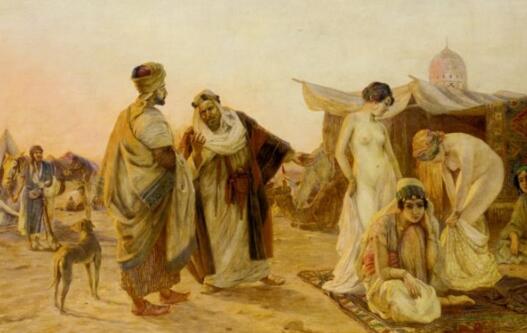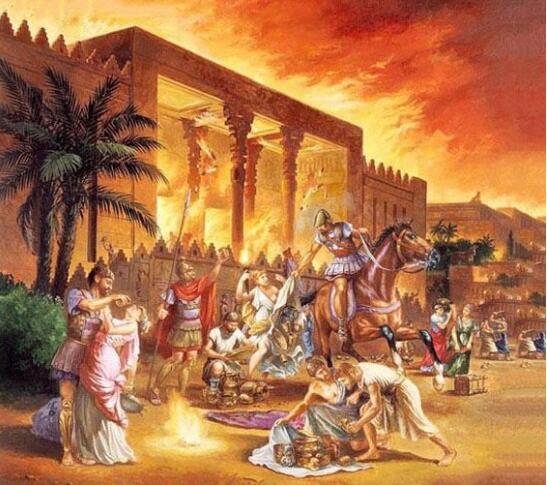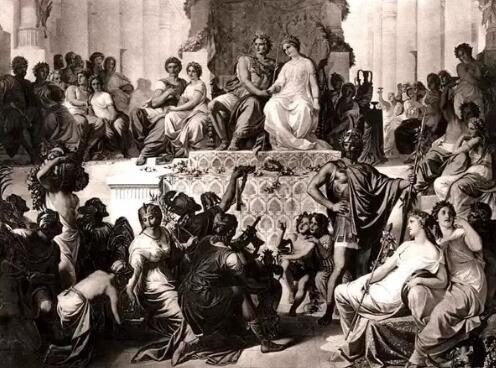 为什么在波斯帝国征服了包括阿拉伯土地在内的其他地方的情况下,波斯人仍然对阿拉伯人的征服怀恨在心?
为什么在波斯帝国征服了包括阿拉伯土地在内的其他地方的情况下,波斯人仍然对阿拉伯人的征服怀恨在心?
Why do Persian people still hold a grudge over the Arab conquest, when Persian empire conquered other places including Arab lands?
译文简介
网友:问题是你如何对待你征服的人。
波斯三次被希腊人、阿拉伯人和蒙古人征服,对伊朗人来说都是噩梦。
正文翻译
Ario Kiani
The issue is how you treat the people you conquer.
Persia was conquered three times by Greeks, Arabs and Mongols and all of them were nightmare for Iranians.
问题是你如何对待你征服的人。
波斯三次被希腊人、阿拉伯人和蒙古人征服,对伊朗人来说都是噩梦。
阿拉伯人 Arabs
The issue is how you treat the people you conquer.
Persia was conquered three times by Greeks, Arabs and Mongols and all of them were nightmare for Iranians.
问题是你如何对待你征服的人。
波斯三次被希腊人、阿拉伯人和蒙古人征服,对伊朗人来说都是噩梦。
阿拉伯人 Arabs

To conquer Persia and force Islam, the Arab invaders resorted to many inhumane actions including massacre, mass enslavement of men, women and children, and imposition of heavy taxes (Jezyeh=Jizya) on those who did not convert. By the order of “Yazid ibn-e Mohalleb” in Gorgan so many Persians were beheaded that their blood mixed with water would energize the millstone to produce as much as one day meal for him, as he had vowed. The event of blood mill has been quoted by the generations of Iranian Zoroastrian families to this day, yet our books of history have been silent about it. In recent years however, disenchanted Iranian scholars have been writing about the blood mills and in fact this event has been reported by our historians of the Islamic era. On the way to Mazandaran the same commander ordered 12,000 captives to be hanged at the two sides of the road so that the victorious Arab army pass through. Upon arrival, many more were massacred in that province and heavy tax (Jizya) was imposed on the survivors who did not convert. Some historians have estimated that a total of 400,000 civilians were massacred. Even though the figure appears inflated, nevertheless it reflects the extent of atrocities committed by the Arab conquerors. After the battle of Alis, the Arab commander (Khalid ibn-e Valid) ordered all the prisoners of war be decapitated so that a creek of blood flows. When the city of Estakhr in the south put up stiff resistance against the Arab invaders, 40,000 residents were slaughtered or hanged. One of the battles by the Arabs has been named, Jelovla (covered), because an estimated 100,000 bodies of the slain Iranian soldiers covered the desert. It is reported that 130,000 Iranian women and children were enslaved and sold in the Mecca and Medina markets and large amount of gold and silver plundered
为了征服波斯和强迫伊斯兰,阿拉伯入侵者采取了许多不人道的行动,包括屠杀、大规模奴役男人、女人和儿童,以及对不皈依者征收重税。在戈尔甘的“Yazid ibn-e Mohalleb”的命令下,如此多的波斯人被斩首,他们的献血染红的河水将像他发誓的那样给水磨提供一天的动力,正如他的誓言那样。血磨坊事件被伊朗琐罗亚斯德教家庭的代代相传,一直引用到今天,然而我们的历史书却对此保持沉默。(译注:戈尔甘是伊朗的一个城市,算是省会,这里的誓言指他对安拉的承诺。既:如果他赢得这场战斗,他将让萨珊人的血流成河。)
但最近几年,不再抱有幻想的伊朗学者一直在写关于血磨坊的文章,事实上,我们的伊斯兰时代历史学家已经报道了这一事件。在去马赞德兰省的路上,这位指挥官命令将12000名俘虏绞死悬挂在道路两旁,以便获胜的阿拉伯军队通过。到达后,更多的人在该省被屠杀,而没有皈依的幸存者被征收重税。
一些历史学家估计总共有40万平民被屠杀,尽管这个数字看起来有些夸张,但它反映了阿拉伯征服者所犯下的暴行的程度。阿利斯战役后,阿拉伯指挥官哈立德·伊本·瓦利德(Khalid ibn-e Valid)下令将所有战俘斩首,血流成河。当南部城市伊斯塔赫尔(Estakhr,萨珊波斯龙兴之地)对阿拉伯入侵者进行顽强抵抗时,40000名居民被屠杀或绞死。阿拉伯人发起的一场战斗被命名为Jelovla (覆盖),因为估计有10万具被杀害的伊朗士兵的尸体覆盖了沙漠。据报道,13万伊朗妇女和儿童被奴役,在麦加和麦地那市场被贩卖,大量金银被掠夺。
(译注:磨坊事件,这个源于伊斯兰历史学家泰伯里的血河事件,指阿拉伯人屠杀萨珊波斯人染红了河水,血河水推动磨坊运作来和面加工制作面包,供给阿拉伯18000士兵吃了三天;根据塔巴里的说法,在无法突破萨珊人的防线时,Yazid ibn-e Mohalleb曾向安拉祈祷,并承诺如果他赢得这场战斗,他将让萨珊人的血流成河。
根据维基百科,以及这里的说法看,Yazid ibn-e Mohalleb应该和哈立德·伊本·瓦利德(Khalid ibn-e Valid)是一个人,可能只是波斯语的叫法音译,一个是阿拉伯语的音译。
在穆斯林重新发起的猛烈进攻面前,萨珊王朝开始逃往希拉。数千人被杀,河岸因死亡人数而变红;哈立德命令手下的一些人公开宣布,被击败的波斯人将被俘虏,而不是被杀死——除非他们进行反击。所以一群又一群人自首,并被带到哈立德那里,但是哈立德却指派他的一些手下在河岸边将他们全部斩首。这样持续了一天一夜。在接下来的两天里,他追击逃跑的波斯士兵,直到他们发现自己被河流逼入绝境。然后他们都被斩首。在Qa'qa ibn Amr的建议下,当他看到血液凝结在土壤上而不是流动时,穆斯林军队的指挥官之一,哈立德下令打开河上的水坝,然后水流入并移动了磨坊,然后他们用面包制作了面包,供他的 18000 名士兵吃三天,从而实现了他的目标早先誓言要用鲜血奔流这条河,后来被称为“血河”。)
History of Zoroastrians & Zoroastrianism in Post Arab Iran. Conditions & Treatment of Zoroastrians 650 CE-1400s
Contents Arab Attitudes Towards the Persians During Their Conquests Islamic Rulers of Iran
Murder of Priests Humiliation as Untouchables Under the Umayyads (661-750 CE) Under the Abbasids (752 - 833 CE) Page 1: Conditions & Treatment of Zoroastrians. 650 CE to Late 1400 s CE Suggested prior reading: Related reading: Arab Attitudes Towards the Persians During Their Conquests [The word 'Arab' does not necessarily mean someone born in Arabia or whose parents were born in Arabia. The Arab nation includes everyone who discarded their native religion, language and culture, and then adopted Islam and Arabic as their religion and 'mother-tongue' respectively, embraced all aspects of Arabic culture, and were loyal to the Arab nation. After the Islamic Arab conquests from China to North Africa, many peoples from those lands became 'Arab'.] During the Caliphate of Umar ibn al-Khatta-b, before the Arabs invaded Iran, they set about capturing the Persian territories in Mesopotamia, the Persian province of Khvarvaran, today's Iraq. When in 637 CE the caliph's armies under the command of Sa'ad ibn Abi Waqqas captured Khvarvaran's capital Ctesiphon (a residence of the Persian Sassanid kings), they burnt its palaces, libraries and archives. According to an account in Tarikh al-Tabari by Al-Tabari, Sa'ad ibn Abi Waqqas wrote to Caliph Umar about enquiring as to what should be done with the books at Ctesiphon. Umar wrote back, "If the books contradict the Qur'an, they are blasphemous. On the other hand, if they are in agreement, they are not needed, as for us Koran is sufficient." Sa'ad ibn Abi Waqqas then ordered the huge library at Ctesiphon destroyed and its priceless books, the work and wisdom of the generations of Persian scientists and scholars were thrown into a fire or into the River Euphrates. The Arabs called the Persians ' Ajam ' meaning mute, and nearly 40,000 captured Persians were shackled and sold as slaves in Arabia. However, retribution was not long coming. A certain Firooz, an enslaved Persian artisan, managed to assassinate the Caliph Umar. Muslim chronicles state that, in the subsequent battle of Ullais, the Arab commander Khalid ibn al-Walid, tired, angry, and frustrated with the resistance put up by the Persians, once victorious, ordered all the prisoners of war be decapitated and their dismembered bodies be thrown into the river. In order to fill the entire river downstream with the blood of the Persians - perhaps as an announcement of his total victory and as a way to strike fear into the remaining Persian armies defending the heartland - Khalid ordered the gates of a dam upstream on the river be opened. The cascading waters swept the bodies and their blood downstream earning it the name - the River of Blood. After the Arabs had conquered the Persian ruled lands west of the Zagros mountains, they began their campaign to conque
琐罗亚斯德教,以及在阿拉伯化的伊朗后的琐罗亚斯德教的历史;琐罗亚斯德教徒在公元650—公元1400年的状况和待遇:
在波斯人征服伊朗的伊斯兰统治者期间,阿拉伯人对波斯人的态度
在倭马亚王朝(公元661-750年)和在阿拔斯王朝(公元752 - 833年)统治下,作为贱民的牧师被羞辱。
公元650年至公元1400年末,建议先阅读的相关资料,如阿拉伯人征服波斯人时对波斯人的态度;这里的‘阿拉伯人’一词不一定指出生在阿拉伯或其父母出生在阿拉伯的人。
阿拉伯民族包括所有抛弃了自己的本土宗教、语言和文化,然后分别采用伊斯兰教和阿拉伯语作为自己的宗教和‘母语’,拥抱阿拉伯文化各个方面,忠于阿拉伯民族的人。
在伊斯兰阿拉伯人从中国征服到北非之后,这些土地上的许多人变成了“阿拉伯人”。
在欧麦尔·伊本·哈塔卜哈里发时期,阿拉伯人入侵伊朗之前,他们就着手夺取美索不达米亚的波斯领土,波斯的克瓦尔瓦兰省,也就是今天的伊拉克。
(译注:欧麦尔·伊本·哈塔卜(Umar ibn al-Khattab,586—644年),被称为欧麦尔一世,阿拉伯哈里发(634—644年在位)。来自穆罕默德所在的古莱氏部落哈希姆族,是早期追随穆罕默德的重要人物之一,也是穆罕默德最忠实的信徒。欧麦尔拥有铁一般的意志,与先知共同经历过“出走麦地那”、“壕沟之战”等重要考验,常常在战役的关键时刻扭转局势。他和第一任哈里发阿布·伯克尔被称为“先知的两大辅弼”。主要成就灭亡波斯,击垮拜占庭,占领埃及。)
公元637年,哈里发的军队在萨阿德·伊本·阿比·瓦卡斯(Sa’ad ibn Abi Waqqas)的指挥下攻占了首都克瓦尔瓦兰的泰西封(Ctesiphon(波斯萨珊王朝国王的住所),他们烧毁了它的宫殿、图书馆和档案馆。
(译注:克瓦尔瓦兰Khvarvaran位于现在的伊拉克首都巴格达附近,曾经是萨珊波斯的首都,不过萨珊波斯之前的首都位于法尔斯省份,迁都是因为这里易守难攻;其建立者是伊朗法尔斯省份的总督,在安息帝国时期造反成功,建立了萨珊波斯;而法尔斯这个省份就是波斯的发源地,类似于中国的中原,波斯其实在波斯语中音译应该叫法尔斯更为准确,不过中国的波斯称呼音译自欧洲。)
Contents Arab Attitudes Towards the Persians During Their Conquests Islamic Rulers of Iran
Murder of Priests Humiliation as Untouchables Under the Umayyads (661-750 CE) Under the Abbasids (752 - 833 CE) Page 1: Conditions & Treatment of Zoroastrians. 650 CE to Late 1400 s CE Suggested prior reading: Related reading: Arab Attitudes Towards the Persians During Their Conquests [The word 'Arab' does not necessarily mean someone born in Arabia or whose parents were born in Arabia. The Arab nation includes everyone who discarded their native religion, language and culture, and then adopted Islam and Arabic as their religion and 'mother-tongue' respectively, embraced all aspects of Arabic culture, and were loyal to the Arab nation. After the Islamic Arab conquests from China to North Africa, many peoples from those lands became 'Arab'.] During the Caliphate of Umar ibn al-Khatta-b, before the Arabs invaded Iran, they set about capturing the Persian territories in Mesopotamia, the Persian province of Khvarvaran, today's Iraq. When in 637 CE the caliph's armies under the command of Sa'ad ibn Abi Waqqas captured Khvarvaran's capital Ctesiphon (a residence of the Persian Sassanid kings), they burnt its palaces, libraries and archives. According to an account in Tarikh al-Tabari by Al-Tabari, Sa'ad ibn Abi Waqqas wrote to Caliph Umar about enquiring as to what should be done with the books at Ctesiphon. Umar wrote back, "If the books contradict the Qur'an, they are blasphemous. On the other hand, if they are in agreement, they are not needed, as for us Koran is sufficient." Sa'ad ibn Abi Waqqas then ordered the huge library at Ctesiphon destroyed and its priceless books, the work and wisdom of the generations of Persian scientists and scholars were thrown into a fire or into the River Euphrates. The Arabs called the Persians ' Ajam ' meaning mute, and nearly 40,000 captured Persians were shackled and sold as slaves in Arabia. However, retribution was not long coming. A certain Firooz, an enslaved Persian artisan, managed to assassinate the Caliph Umar. Muslim chronicles state that, in the subsequent battle of Ullais, the Arab commander Khalid ibn al-Walid, tired, angry, and frustrated with the resistance put up by the Persians, once victorious, ordered all the prisoners of war be decapitated and their dismembered bodies be thrown into the river. In order to fill the entire river downstream with the blood of the Persians - perhaps as an announcement of his total victory and as a way to strike fear into the remaining Persian armies defending the heartland - Khalid ordered the gates of a dam upstream on the river be opened. The cascading waters swept the bodies and their blood downstream earning it the name - the River of Blood. After the Arabs had conquered the Persian ruled lands west of the Zagros mountains, they began their campaign to conque
琐罗亚斯德教,以及在阿拉伯化的伊朗后的琐罗亚斯德教的历史;琐罗亚斯德教徒在公元650—公元1400年的状况和待遇:
在波斯人征服伊朗的伊斯兰统治者期间,阿拉伯人对波斯人的态度
在倭马亚王朝(公元661-750年)和在阿拔斯王朝(公元752 - 833年)统治下,作为贱民的牧师被羞辱。
公元650年至公元1400年末,建议先阅读的相关资料,如阿拉伯人征服波斯人时对波斯人的态度;这里的‘阿拉伯人’一词不一定指出生在阿拉伯或其父母出生在阿拉伯的人。
阿拉伯民族包括所有抛弃了自己的本土宗教、语言和文化,然后分别采用伊斯兰教和阿拉伯语作为自己的宗教和‘母语’,拥抱阿拉伯文化各个方面,忠于阿拉伯民族的人。
在伊斯兰阿拉伯人从中国征服到北非之后,这些土地上的许多人变成了“阿拉伯人”。
在欧麦尔·伊本·哈塔卜哈里发时期,阿拉伯人入侵伊朗之前,他们就着手夺取美索不达米亚的波斯领土,波斯的克瓦尔瓦兰省,也就是今天的伊拉克。
(译注:欧麦尔·伊本·哈塔卜(Umar ibn al-Khattab,586—644年),被称为欧麦尔一世,阿拉伯哈里发(634—644年在位)。来自穆罕默德所在的古莱氏部落哈希姆族,是早期追随穆罕默德的重要人物之一,也是穆罕默德最忠实的信徒。欧麦尔拥有铁一般的意志,与先知共同经历过“出走麦地那”、“壕沟之战”等重要考验,常常在战役的关键时刻扭转局势。他和第一任哈里发阿布·伯克尔被称为“先知的两大辅弼”。主要成就灭亡波斯,击垮拜占庭,占领埃及。)
公元637年,哈里发的军队在萨阿德·伊本·阿比·瓦卡斯(Sa’ad ibn Abi Waqqas)的指挥下攻占了首都克瓦尔瓦兰的泰西封(Ctesiphon(波斯萨珊王朝国王的住所),他们烧毁了它的宫殿、图书馆和档案馆。
(译注:克瓦尔瓦兰Khvarvaran位于现在的伊拉克首都巴格达附近,曾经是萨珊波斯的首都,不过萨珊波斯之前的首都位于法尔斯省份,迁都是因为这里易守难攻;其建立者是伊朗法尔斯省份的总督,在安息帝国时期造反成功,建立了萨珊波斯;而法尔斯这个省份就是波斯的发源地,类似于中国的中原,波斯其实在波斯语中音译应该叫法尔斯更为准确,不过中国的波斯称呼音译自欧洲。)

泰西封遗址
根据泰伯里在《历代先知和帝王史》的叙述,赛义德·本·阿比·瓦卡斯(Sa'ad ibn Abi Waqqas)写信给哈里发欧麦尔,询问如何处理泰西封的书籍。
(译注:泰伯里(Tabari,838~923年),祖籍波斯,全名穆罕默德· 本· 杰里尔·本· 耶济德·本·哈里德,号艾布·贾法尔,生于里海南岸泰伯里斯坦(今伊朗马赞德兰省)的阿莫勒,并以出生地泰伯里著称于世。他是中世纪著名的《古兰经》注释家、圣训学家、伊斯兰教法学家、历史学家,阿拉伯编年体史书鼻祖。阿拉伯史学家称泰伯里为“伊斯兰经注学的长老”、“阿拉伯历史学的奠基者”。)
欧麦尔回信说,“如果这些书与《古兰经》相矛盾,它们就是亵渎神明。
另一方面,如果它们是一致的,它们也是不需要的,对我们来说,古兰经以及足够了。”
赛义德·本·阿比·瓦卡斯随后下令摧毁位于泰西封的巨大图书馆,将其中价值连城的书籍、几代波斯科学家和学者的著作和智慧投入火中或幼发拉底河中。
阿拉伯人把波斯人叫做‘Ajam’,意思是哑巴,将近4万名被俘的波斯人被戴上镣铐,卖到阿拉伯当奴隶。
然而,报应很快就来了。一个叫菲鲁兹的被奴役的波斯工匠设法暗杀了哈里发欧麦尔。
穆斯林编年史记载说,在随后的乌来斯战役中,阿拉伯指挥官哈立德·本·瓦利德对波斯人的抵抗感到疲惫、愤怒和沮丧,他一旦获胜,就下令将所有战俘斩首,并将他们的碎尸扔进河里;为了让下游的河流充满波斯人的鲜血——也许是为了宣告他的彻底胜利,也许为了让守卫中心地带的剩余波斯军队感到恐惧——哈立德下令打开河流上游的水坝闸门。奔流的河水将尸体和他们的血液冲向下游,由此诞生了一个名词——血河。阿拉伯人征服了扎格罗斯山脉以西由波斯人统治的土地后,他们开始了征服的战争。
(译注:琐罗亚斯德教是在基督教诞生之前在中东最有影响的宗教,是古代波斯帝国的国教,也是中亚等地的宗教。是摩尼教之源,在中国称为“祆(xiān)教”。琐罗亚斯德教是流行于古代波斯(今伊朗)及中亚等地的宗教,中国史称祆教、火祆教、拜火教。北魏时,祆教传入中国洛阳。倚天屠龙记里面的明教就是摩尼教,拜火教的分支。琐罗亚斯德教是伊斯兰教诞生之前西亚最有影响的宗教,古代波斯帝国的国教,曾被伊斯兰教徒称为“拜火教”。琐罗亚斯德教的教义一般认为是神学上的一神论和哲学上的二元论。琐罗亚斯德教的经典主要是《阿维斯塔》,意为知识、谕令、或经典,通称《波斯古经》。)
https://www.heritageinstitute.com/zoroastrianism/history/postArab.htm
Mongols
The Mongol invasion was disastrous for Iranians. The Mongols killed many Iranian civilians, destruction of qanat irrigation systems destroyed the pattern of relatively continuous Settlement, producing numerous isolated oasis cities in a land where they had previously been rare. A large number of people, particularly males, were killed between 1220 and 1258, 90% of total population of Iran may have been killed as a result of mass extermination and famine.
蒙古人
蒙古人的入侵对伊朗人来说是灾难性的。蒙古人杀害了许多伊朗平民,对坎儿井灌溉系统的破坏,破坏了相对连续的定居模式,在这片土地上产生了许多孤立的绿洲城市,这在以前是罕见的。大量的人,尤其是男性,在1220年至1258年间被杀害,伊朗总人口的90%可能是由于大规模灭绝和饥荒而被杀害的。
Mongols
The Mongol invasion was disastrous for Iranians. The Mongols killed many Iranian civilians, destruction of qanat irrigation systems destroyed the pattern of relatively continuous Settlement, producing numerous isolated oasis cities in a land where they had previously been rare. A large number of people, particularly males, were killed between 1220 and 1258, 90% of total population of Iran may have been killed as a result of mass extermination and famine.
蒙古人
蒙古人的入侵对伊朗人来说是灾难性的。蒙古人杀害了许多伊朗平民,对坎儿井灌溉系统的破坏,破坏了相对连续的定居模式,在这片土地上产生了许多孤立的绿洲城市,这在以前是罕见的。大量的人,尤其是男性,在1220年至1258年间被杀害,伊朗总人口的90%可能是由于大规模灭绝和饥荒而被杀害的。
Greeks
Although Greeks treated Iranians better than Arabs and Mongols but they were not so great
Burning of Persepolis by Alexander
希腊人
虽然希腊人对伊朗人比对阿拉伯人和蒙古人好,但他们也没那么好。
亚历山大焚烧波斯波利斯
Although Greeks treated Iranians better than Arabs and Mongols but they were not so great
Burning of Persepolis by Alexander
希腊人
虽然希腊人对伊朗人比对阿拉伯人和蒙古人好,但他们也没那么好。
亚历山大焚烧波斯波利斯

https://www.thoughtco.com/why-did-alexander-burn-persepolis-116832
Under Alexander's orders the family of Darius (his wife, mother, daughters and son), were treated well and allowed to retain their social status, but many captured Persian women were treated brutally.
Greek men praised beauty of Persian women so we can imagine what happened when they had access to these women also Alexander forced more than 10000 Persian women to married Greek men.
在亚历山大的命令下,大流士的家人(他的妻子、母亲、女儿和儿子)受到良好的对待,并被允许保留他们的社会地位,但许多被俘的波斯妇女受到了残酷的对待。
希腊男人赞美波斯女人的美丽,所以我们可以想象当他们接近这些女人时会发生什么。
亚历山大还强迫10000多名波斯女人嫁给希腊男人。

.
But how did Cyrus the great and Persians treat the people they conquered?
但是居鲁士大帝和波斯人是如何对待他们征服的民族的呢?

In October 539 BCE, Cyrus the Great entered Babylonia in peace without being engaged in any battle. Babylonia was thereafter incorporated into the Persian Achaemenid realm as a satrapy. As Cyrus vowed in his cylinder to respect the people of Babylon, and since he liberated the incarcerated Jews to be returned to their homeland, he was viewed as the legitimate successor of the ancient Babylonian kings and became popular in Babylon itself, in contrast to Nabonidus.
公元前539年10月,居鲁士大帝平静地进入巴比伦,没有在城里进行任何战争杀戮。此后,巴比伦被并入波斯阿契美尼德王朝作为领地。因为居鲁士在他的圆柱上发誓要尊重巴比伦人民,而且因为他解放了被监禁的犹太人,让他们重返家园,所以他被视为古巴比伦国王的合法继承人,并在巴比伦当地也受到欢迎,与那波尼德斯形成对比。
(译注:那波尼德斯,新巴比伦王国第五任君主。圆柱应该是居鲁士圆柱,记载着居鲁士公元前539年征服巴比伦等内容,是具有2500多年历史的著名文物,居鲁士圆柱于1879年被发现,之后就一直收藏在大英博物馆。居鲁士登基成为波斯世界霸权的君主之后,他在公元前539年攻占巴比伦的事迹被记录在一条黏土圆柱上。部分内容的译文如下:“我是居鲁士,世界之王、伟大的王、强有力的王、巴比伦王、苏美尔和阿卡德王、(天下)四方之王,……我把被集中到这里(巴比伦城)的神像送回了他们的宫殿,使他们居住在永久的居所之中。我掌控所有的居民,使他们回到他们的居住地;居鲁士圆柱表明波斯王的政策是要将被掳的民族遣返原居地。居鲁士下令让犹太人返回耶路撒冷和重建耶和华的殿是与这项政策完全一致的。居鲁士圆柱不仅是波斯阿契美尼王朝建立的宣言,其碑文也是人类历史上第一部人权宣言。它是一份对宗教和种族自由的倡议书;它废除了奴隶制和任何形式的压迫,禁止使用武力或掠夺手段攫取财产;它还赋予成员国自主决定是否臣服于居鲁士大帝的选择权。)
评论翻译
很赞 ( 6 )
收藏
The issue is how you treat the people you conquer.
Persia was conquered three times by Greeks, Arabs and Mongols and all of them were nightmare for Iranians.
问题是你如何对待你征服的人。
波斯三次被希腊人、阿拉伯人和蒙古人征服,对伊朗人来说都是噩梦。
阿拉伯人 Arabs